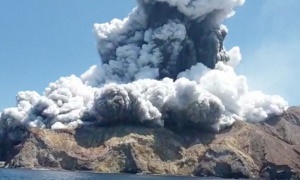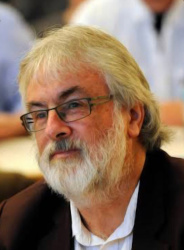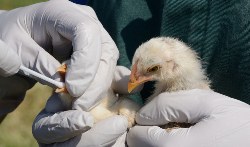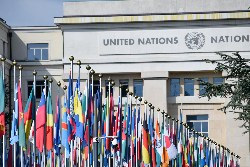Gordon Campbell on a White Island inquiry
Gordon Campbell on what any White Island inquiry might look like
First published on Werewolf Presumably, if there is
to be a ministerial inquiry (at the very least) into the
Whakaari/White Island disaster, it will need to be a
joint ministerial inquiry. That’s because the relevant
areas of responsibility seem to be so deeply interwoven :
Police Minister Stuart Nash, Workplace Health and Safety
Minister Ian Lees-Galloway, Tourism Minister Kelvin Davis
and GNS Science Minister Megan Woods would all seem to have
much to contribute, and many questions to answer.
Presumably, if there is
to be a ministerial inquiry (at the very least) into the
Whakaari/White Island disaster, it will need to be a
joint ministerial inquiry. That’s because the relevant
areas of responsibility seem to be so deeply interwoven :
Police Minister Stuart Nash, Workplace Health and Safety
Minister Ian Lees-Galloway, Tourism Minister Kelvin Davis
and GNS Science Minister Megan Woods would all seem to have
much to contribute, and many questions to answer.
In the aftermath of the disaster, some of the most pressing questions have had to do with the nature of the relationship between GNS Science and the tour companies. I’d initially thought that the problematic inability and/or unwillingness of GNS Science to issue stronger warnings about the risks of taking tours to White Island was a simple reflection of the scientists operating at arms length from the commercial tour operators. Indeed, any future inquiry will need to examine whether the scientists had (or should have had) the regulatory power and legal protection to issue stronger deterrent public warnings, even if those warnings impacted negatively on tour operator finances.
As things stand, GNS Science might have felt that it could potentially face being sued if its staff statements had the effect of shutting down or curtailing the White Island tours, especially given that the summer cruise ship season had begun in earnest only a month beforehand. In general terms, the law actively protects commercial firms from allegations that affect their prosperity, by punishing those who make damaging allegations on anything less than rock solid grounds. Did this consideration have a chilling effect on the readiness of GNS Science to act pre-emptively, and warn tourists off the volcano? That’s for an inquiry to explore.
Initially, I’d assumed that GNS Science had been issuing its carefully conservative warnings in impotent isolation from the tour operators – who were largely being left to make the judgements calls about the acceptable risks, even though they had an obvious commercial incentive to push out the boundaries of risk. Yet the actual situation seems to have been even worse. Some prior public statements by GNS Science appeared to actively discount the risks, as if its primary role had been to re-assure the public that such risks and concerns were minimal – despite its own recent observations that the risks were high and on the increase, and in a situation where a fatal eruption could occur without further warning.
In early December, GNS Science had reported increasing volcanic activity, subsequent to the prior elevated risk warning that it issued on November 18. The bolded emphasis in this December 3rd GNS Science release is mine:
Moderate volcanic unrest continues at Whakaari/White Island, with substantial gas, steam and mud bursts observed at the vent located at the back of the crater lake…..Explosive gas and steam-driven mud jetting continues from the active vent area at the back of the crater lake on Whakaari/White Island. The level of activity at the vent is variable and when in a stronger phase, some material is being deposited about the vent area. This style of activity has been present since late September, although it is occurring more frequently now…
Volcanic gas emission and seismic activity continue to remain elevated…. Volcanic tremor also remains at moderate levels in the last week, with some periodic variations, matched with episodes of increased gas-steam jetting and fountaining….This fountaining is regularly throwing mud and debris 20-30 metres into the air above the vent. The level of activity is variable and remains within the range expected for moderate volcanic unrest. While the activity is contained to the far side of the lake, the current level of activity does not pose a direct hazard to visitors. The monitoring observations bear some similarities with those seen during the 2011-2016 period when Whakaari/White Island was more active and stronger volcanic activity occurred. Observations and data to date suggest that the volcano may be entering a period where eruptive activity is more likely than normal.
Note the re-assuring commentary: “While the activity is contained to the far side of the lake, the current level of activity does not pose a direct hazard to visitors…” In other words, so long as the volcano obligingly confined its activities to one side of the lake, no “direct” hazard existed for visitors and all would be well. Clearly, there was never a particularly solid scientific basis for such an assurance. In November, GNS volcanologist Dr Michael Rosenburg had indicated that the changes being observed may or may not be a signal that something was happening, but this uncertainty shouldn’t be cause for undue concern.
"The White Island volcano is really complicated and just because one thing changes, it doesn't necessarily mean that everything else will change and it doesn't necessarily mean that this is going to lead to an eruption.” Dr Rosenburg said tour groups could still visit the island.
Note the emphasis. The observations on White Island were being construed by GNS Science staff in ways that -unintentionally or otherwise - enabled the tours to continue unimpeded by any warning shot across their bows. As part of this re-assurance process, current activity was being rosily evaluated through the rear view mirror of the 2011-2016 eruptions (ie where no death of injury ensued.)
Yet if you look back at that GNS Science’s December 3rd evaluation, it was being observed that when current activity was ‘in a stronger phase, some material was being deposited around the vent area.’ This seems highly relevant because…in the aftermath of the eruption, the public has been told that this fatal superheated steam eruption occurred because volcanic activity had created a seal across the vents. Yet it seems as if GNS Science had been watching that process of the sealing materials being deposited, but without raising the alarm level. And without additionally warning the tour operators - or the public - of the potential consequences.
Liability May Still Bite Us
As my initial column warned last Tuesday morning, the Royal Caribbean line that operates the Ovation of the Seas cruise ship could well face legal action from foreign tourists or from family members of foreigners killed or injured on White Island. As Werewolf put it six days ago:
The fact that tours exist and get carried off daily without incident ( so far, so good) inevitably creates a false sense of security. In many other countries, the prospect of being sued puts something of a brake on risky tourism activities and practices. Yet in New Zealand, the profits of adventure tourism are privatised, but the risks are socialised. By and large, individuals and firms can’t be sued in the event of accidents. ( It will be interesting to see if the cruise shipping line avoids overseas litigation for any onboard promoting it did of the White Island tours.) Here, the Accident Compensation scheme provides a safety net that largely spares tour operators from carrying the economic weight of responsibility if, and when, the worst should happen.
No doubt, visitors would have signed a waiver exempting the tour operators from liability. Yet it seems doubtful that before signing that consent form, our foreign visitors were fully informed of the (increasing) risk environment that existed on the island, or were adequately advised they were entering a risk situation where no effective exit plan existed, or was even possible:
In effect, tourists were being taken into a risk environment where no adequate method existed for evaluating and responding in any meaningful time, to the chronic risk of death and injury. White Island was safe, but only until such time as it suddenly wasn’t. (Were the tourists advised beforehand of the likely fatal outcome of a worst case scenario? Probably not.)
To all appearances, Royal Caribbean would now seem highly vulnerable to a major lawsuit, given that it was actively engaged in promoting the tours on board the Ovation of the Seas:
In the wake of the deadly volcanic eruption, which has killed five people and left dozens unaccounted for, Royal Caribbean has pulled an advertisement for its $398 tour to the deadly White Island. Spruiking a way for passengers to get “close to the drama”, the seven-hour tour starts with a scenic boat ride through the Bay of Plenty to White Island for an “unforgettable” tour of “New Zealand’s most active volcano”.
Arriving on-board inflatable crafts, the tour takes guests “from your boat directly into the crater complex”.
“You head straight into the action without much, if any, climbing at all,” the advertisement reads. The guided tour allows guests to “get up close to roaring steam vents, bubbling pits of mud, volcanic hot streams” as well as an “amazing lake of steaming acid” all with the assistance of gas masks and breathing apparatus.
Where, and to what extent, Royal Caribbean mentioned the risks involved (in any language fit to balance those glowing endorsements) remains to be seen. If a lawsuit does eventuate, the cruise ship operators would appear to have only (a) the consent form and (b) the prior assurances and threat levels issued by the scientists at GNS Science to rely on in their own defence.
In other words, this country’s volcanologists and the regulatory framework of our adventure tourism industry would seem to be running a serious risk of being hauled into the international spotlight, in the course of a high profile compensation case. Food for thought – for both GNS Science Minister Megan Wood and Tourism Minister Kelvin Davis - if and when our joint ministerial inquiry ever gets off the ground. What is our damage limitation plan, if New Zealand is to avoid being painted in overseas media as the Wild West of adventure tourism? Not to mention how we aim to protect our scientists from being called on to defend the cruise shipping line that’s likely to be at the centre of this looming legal storm?
Footnote One: It is not as if GNS Science consciously massaged its findings in the service of commerce. But there are reasonable grounds for thinking it may have inadvertently done so. The palpable skew of GNS Science commentary towards assuring the public there was nothing untoward about White Island developments to worry about was not limited to those mid-November/early December reports. In late October (and underneath the Stuff headline “Rising SO2 gas output, volcanic tremor at White Island could suggest eruptive activity more likely”) GNS Science duty volcanologist Yannik Behr was relatively upbeat, while conceding that science didn’t really know how to interpret what it was seeing with any certainty:
The changes at White Island could also be explained by increased gas flux - the rate at which gas is coming through the system. The link between gas flux and future activity was not well understood, GNS Science duty volcanologist Yannik Behr said. There was a "level of uncertainty" about the meaning of the changes…
But hey, no real cause for alarm - not if you assumed that in future, White Island would continue to safely behave much as it had in the recent past:
None of the monitored parameters at White Island were outside the expected range for minor volcanic unrest and associated hazards. "While the pattern of signals shows similarities with the 2011-2016 period and could suggest that Whakaari/White Island may be entering a period where eruptive activity is more likely than normal, recent observations can also be explained by the increased gas flux which leads to geysering and lake level changes," Behr said. Research was underway to try to better understand the link between gas flux and future activity at the volcano.
Good to know.
Footnote Two. Political junkies may be interested that former National MP Paul Quinn is the chair of White Island Tours. While in Parliament, Quinn was the originator of the legislation that denied all prisoners the vote - despite the legislation being officially faulted at the time by then-Attorney General Chris Finlayson, for contravening the Human Rights Act.


 Gordon Campbell: On Iran Killing Its Rappers, And Searching For The Invisible Dr. Reti
Gordon Campbell: On Iran Killing Its Rappers, And Searching For The Invisible Dr. Reti Peter Dunne: MPs Unusually Quiet On Pay Rise
Peter Dunne: MPs Unusually Quiet On Pay Rise Ian Powell: Cuba And New Zealand: A Relationship Worthy Of Strengthening
Ian Powell: Cuba And New Zealand: A Relationship Worthy Of Strengthening Gordon Campbell: On bird flu, AUKUS entry fees and Cindy Lee
Gordon Campbell: On bird flu, AUKUS entry fees and Cindy Lee Binoy Kampmark: Israel’s Anti-UNRWA Campaign Falls Flat
Binoy Kampmark: Israel’s Anti-UNRWA Campaign Falls Flat Peter Dunne: Luxon Gets Out His Butcher's Knife - Briefly
Peter Dunne: Luxon Gets Out His Butcher's Knife - Briefly